
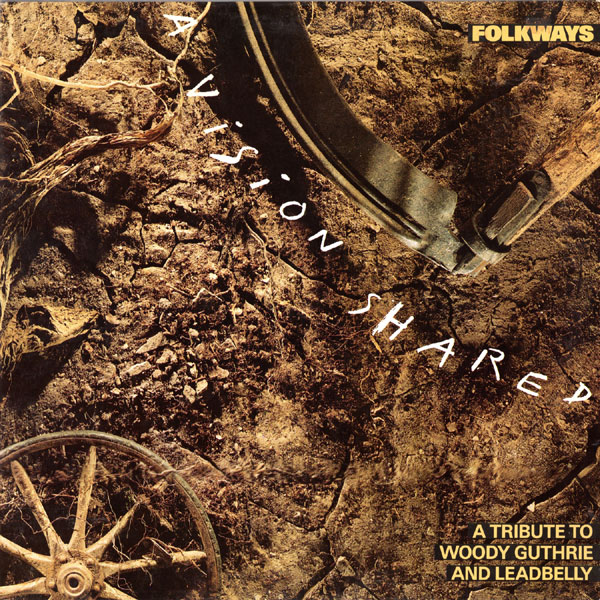 |
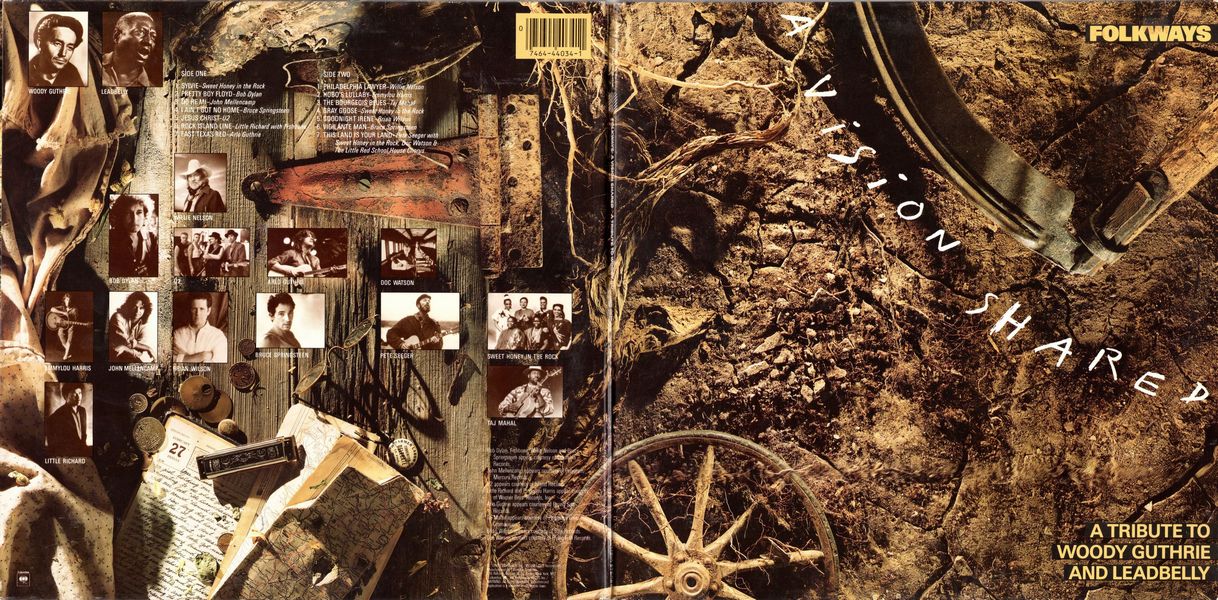
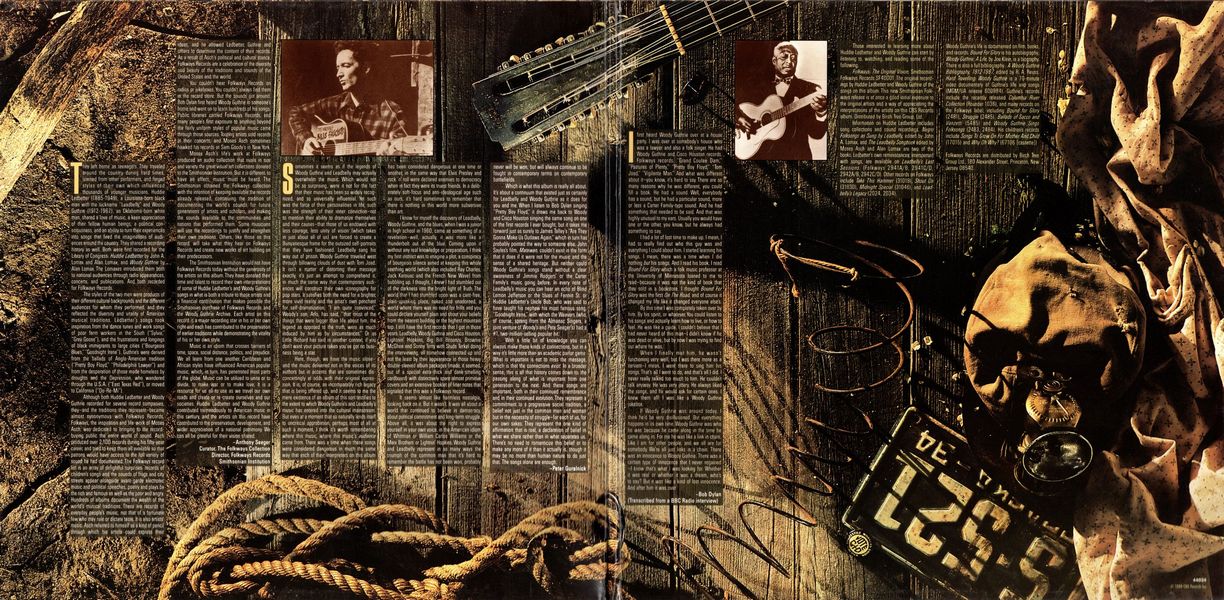 |
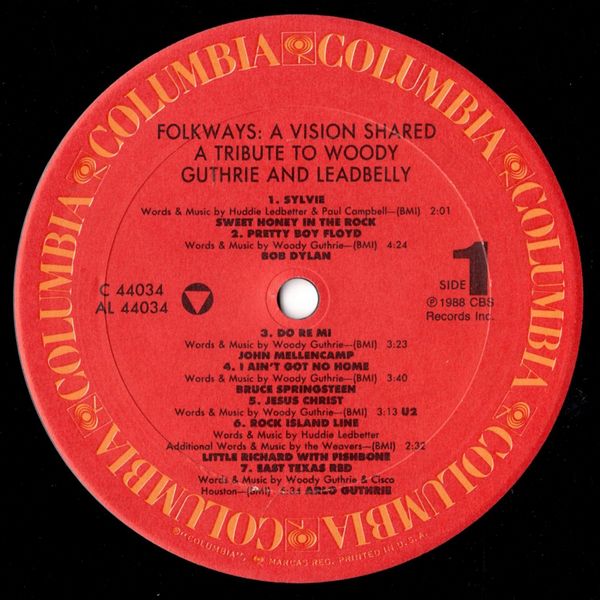
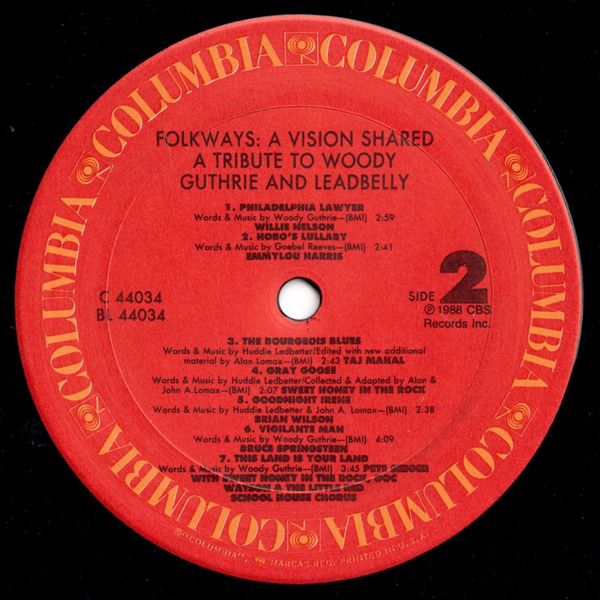
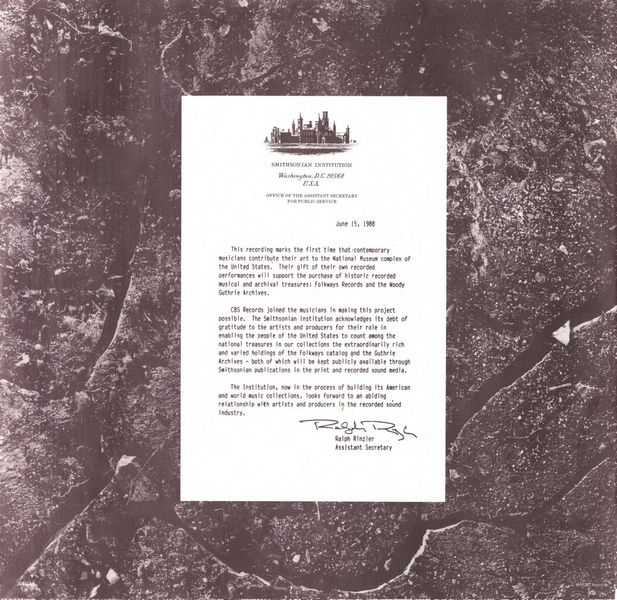
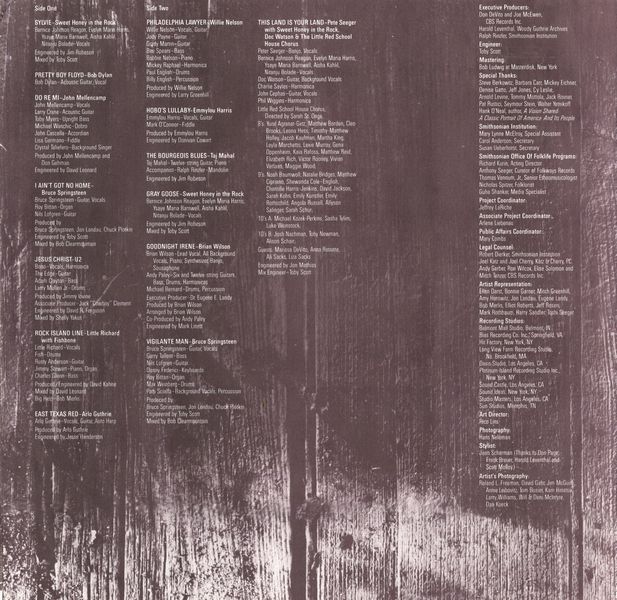
|
Sleeve Notes
June 15, 1988
This recording marks the first time that contemporary musicians contribute their art to the National Museum complex of the United States. Their gift of their own recorded performances will support the purchase of historic recorded musical and archival treasures: Folkways Records and the Woody Guthrie Archives.
CBS Records joined the musicians in making this project possible. The Smithsonian Institution acknowledges its debt of gratitude to the artists and producers for their role in enabling the people of the United States to count among the national treasures in our collections the extraordinarily rich and varied holdings of the Folkways catalog and the Guthrie Archives - both of which will be kept publicly available through Smithsonian publications in the print and recorded sound media.
The Institution, now in the process of building its American and world music collections, looks forward to an abiding relationship with artists and producers in the recorded sound industry.
Assistant Secretary
Smithsonian Institution
Ralph Rinzler
They left home as teenagers. They traveled around the country during hard times, learned from other performers, and forged styles of their own which influenced thousands of younger musicians. Huddie Ledbetter (1885-1949), a Louisiana-born black man with the nickname "Leadbelly," and Woody Guthrie (1912-1967), an Oklahoma-born white man, shared a love of music, a keen appreciation of their fellow human beings, a political consciousness, and an ability to turn their experiences into songs that fired the imaginations of audiences around the country. They shared a recording history as well. Both were first recorded for the Library of Congress: Huddie Ledbetter by John A. Lomax and Alan Lomax, and Woody Guthrie by Alan Lomax. The Lomaxes introduced them both to national audiences through radio appearances, concerts, and publications. And both recorded for Folkways Records.
The styles of the two men were products of their different cultural backgrounds and the different audiences for whom they performed, and they reflected the diversity and vitality of American musical traditions. Ledbetter's songs took inspiration from the dance tunes and work songs of poor farm workers in the South ("Sylvie," "Grey Goose"), and the frustrations and longings of black immigrants to large cities ("Bourgeois Blues," "Goodnight Irene"). Guthrie's were derived from the ballads of Anglo-American tradition ("Pretty Boy Floyd," "Philadelphia Lawyer") and from the desperation of those made homeless by droughts and the Depression, who wandered through the U.S.A. ("East Texas Red"), or moved to California ("Do-Re-Mi").
Although both Huddie Ledbetter and Woody Guthrie recorded for several record companies, they — and the traditions they represent — became almost synonymous with Folkways Records. Folkways, the inspiration and life-work of Moses Asch, was dedicated to bringing to the recordbuying public the entire world of sound. Asch produced over 2,100 records during his fifty-year career, and tried to keep them all available so that patrons would have access to the full variety of sound he had documented. The Folkways record list is an array of delightful surprises: records of children's songs and the sounds of frogs and city streets appear alongside avant-garde electronic music and political speeches, poetry and plays by the rich and famous as well as the poor and angry. Hundreds of albums document the wealth of the world's musical traditions. These are records of everyday people's music, not that of a fortunate few who may rule or dictate taste. It is also artists' music. Asch referred to himself as a kind of pencil through which his artists could express their ideas, and he allowed Ledbetter, Guthrie and others to determine the content of their records. As a result of Asch's political and cultural stance. Folkways Records are a celebration of the diversity and beauty of the traditions and sounds of the United States and the world.
You couldn't hear Folkways Records on radios pr jukeboxes. You couldn't always find them in the record store. But the sounds got around, Bob Dylan first heard Woody Guthrie in someone's home and went on to learn hundreds of his songs. Public libraries carried Folkways Records, and many people's first exposure to anything beyond the fairly uniform styles of popular music came through those sources. Touring artists sold records at their concerts, and Moses Asch sometimes hawked his records at Sam Goody's in New York.
Moses Asch's life's work at Folkways produced an audio collection that rivals in size and variety the great visual art collections donated to the Smithsonian Institution. But it is different: to have an effect, music must be heard. The Smithsonian obtained the Folkways collection with the intention of keeping available the records already released, continuing the tradition of documenting the world's sounds for future generations of artists and scholars, and making the sounds available to the communities and nations that performed them. Some musicians will use the recordings to justify and strengthen their own traditions. Others, like those on this record, will take what they hear on Folkways Records and create new works of an building on their predecessors.
The Smithsonian Institution would not have Folkways Records today without the generosity of the artists on this album. They have donated their time and talent to record their own interpretations of some of Huddie Ledbetter's and Woody Guthrie's songs in what is both a tribute to those artists and a financial contribution that makes possible the Smithsonian purchase of Folkways Records and the Woody Guthrie Archive. Each artist on this record is a major recording star in his or her own right and each has contributed to the preservation of earlier traditions while demonstrating the vitality of his or her own style.
Music is an idiom that crosses barriers of time, space, social distance, politics, and prejudice. We all learn from one another. Caribbean and African styles have influenced American popular music, which, in turn, has penetrated most parts of the globe. Music can be utilized to unite or to divide, to make war or to make love. It is a resource for us all to use as we travel our own roads and create or re-create ourselves and our societies. Huddie Ledbetter and Woody Guthrie contributed tremendously to American music in this century, and the artists on this record have contributed to the preservation, development, and wider appreciation of a national patrimony. We can all be grateful for their vision shared.
— Anthony Seeger
Curator, The Folkways Collection
Director, Folkways Records Smithsonian Institution
Sometimes it seems as if the legends of Woody Guthrie and Leadbelly may actually overwhelm the music. Which would not be so surprising, were it not for the fact that their music has been so widely recognized, and so universally influential. Yet such was the force of their personalities in life, such was the strength of their inner conviction — not to mention their ability to dramatize themselves and their causes — that those of us endowed with less courage, less unity of vision (which takes in just about all of us) are forced to create a Bunyanesque frame for the outsized self-portraits that they have fashioned. Leadbelly sang his way out of prison. Woody Guthrie traveled west through billowing clouds of dust with Tom Joad.
It isn't a matter of distorting their message exactly, it's just an attempt to comprehend it, in much the same way that contemporary audiences will construct their own iconography for pop stars. It satisfies both the need for a brighter, more vivid reality and the artist's own penchant for self-dramatization. "I am quite convinced," Woody's son, Arlo, has said, "that most of the things that were bigger than life about him, the legend as opposed to the truth, were as much induced by him as by circumstances." Or as Little Richard has said in another context, if you don't want your picture taken you've got no business being a star.
Here, though, we have the music alone — and the music delivered not in the voices of its authors but in accents that are sometimes disconcertingly at odds with their original expression. It is, of course, an incomparably rich legacy that is being offered up, and it seems to me the mere existence of an album of this sort testifies to the extent to which Woody Guthrie's and Leadbelly's music has entered into the cultural mainstream. But even at a moment that so naturally lends itself to uncritical approbation, perhaps most of all at such a moment, I think it's worth remembering where this music, where this music's audience came from. There was a time when these songs were considered dangerous in much the same way that each of their interpreters on this album has been considered dangerous at one time or another, in the same way that Elvis Presley and rock 'n' roll were declared enemies to democracy when in fact they were its truest friends. In a deliberately soft-focus and anti-ideological age such as ours, it's hard sometimes to remember that there is nothing in this world more subversive than art.
I know for myself the discovery of Leadbelly, Woody Guthrie, and the blues, when I was a junior in high school in 1960, came as something of a revelation — well, actually, it was more like a thunderbolt out of the blue. Coming upon it without any real knowledge or preparation, I think my first instinct was to imagine a plot, a conspiracy of bourgeois silence aimed at keeping this whole seething world (which also included Ray Charles, Jack Kerouac and the French New Wave) from bubbling up. I thought, I knew I had stumbled out of the darkness into the bright light of Truth. The world that I had stumbled upon was a cant-free, plain-speaking place, naked end unadorned, a world where there was no need for frills and you could declare yourself plain and shout your beliefs from the nearest building or the highest mountain top. I still have the first records that I got in those years: Leadbelly, Woody Guthrie and Cisco Houston, Lightnin' Hopkins, Big Bill Broonzy, Brownie McGhee and Sonny Terry with Studs Terkel doing the interviewing, all somehow connected up and not the least by their appearance in those heavy double-sleeved album packages (made, it seemed, out of a special extra-thick and dank-smelling cardboard) with distinctively spare almost primitive covers and an extensive booklet of liner notes that signaled that this was a Folkways record.
It seems almost like harmless nostalgia, looking back on it. But it wasn't. It was all about a world that continued to believe in democracy, about political commitment and long-term struggle. Above all, it was about the right to express yourself in your own voice, in the American idiom of Whitman or William Carlos Williams or the Marx Brothers or Lightnin' Hopkins. Woody Guthrie and Leadbelly represent in so many ways the triumph of the common man that it's hard to remember the battle has not been won, probably never will be won, but will always continue to bo fought in contemporary terms on contemporary battlefields.
Which is what this album is really all about It's about a continuum that existed |ust as certainly for Leadbelly and Woody Guthrie as it does for you and me. When I listen to Bob Dylan singing "Pretty Boy Floyd," it draws me back to Woody and Cisco Houston singing the same song on one of the first records I ever bought, but it takes me forward just as surely to James Talley's "Are They Gonna Make Us Outlaws Again," which in turn has probably pointed the way to someone else. John Sayles's film, Matewan. couldn't exist in the form that it does if it were not for the music and the sense of a shared heritage. But neither could Woody Guthrie's songs stand without a clear awareness of Jimmie Rodgers' or the Carter Family's music going before. In every note of Leadbelly's music you can hear an echo of Blind Lemon Jefferson or the blues of Fannin St or Huddie Ledbetter's Uncle Bob, who was said to have taught his nephew his most famous song, "Goodnight Irene," with which the Weavers (who, of course, sprang from the Almanac Singers, a joint venture of Woody's and Pete Seeger's) had a #1, two-million-selling popular hit.
With a little bit of knowledge you can always make these kinds of connections, but in a way it's little more than an academic parlor game What is important is not to miss the message, which is that the connections exist, In a broader sense, this is all that history comes down to the passing along of what is important from one generation to the next. And these songs are important, both in their continued remembrance and in their continued evolution. They represent a commitment to a progressive social tradition, a belief not just in the common man and woman but in the necessity of struggle for each of us, for our own sakes. They represent the one kind of affirmation that is real, a declaration of belief in what we share rather than in what separates us. There's no need to romanticize this belief make any more of it than it actually is, though it may be no more than human nature to do just that. The songs alone are enough.
— Peter Guralnick
I first heard Woody Guthrie over at a house. party. I was over at somebody's house who was a lawyer and also a folk singer. He had Woody Guthrie and Cisco Houston records. Folkways records. "Grand Coulee Dam," "Pastures of Plenty," "Pretty Boy Floyd,” "Tom Joad," "Vigilante Man." And what was different about it — you know, it's hard to say. There are so many reasons why he was different, you could. fill a book. He had a sound. Well, everybody has a sound, but he had a particular sound, more or less a Carter Family-type sound. And he had something that needed to be said. And that was highly unusual to my ears. Usually you would have one or the other, you know, but he always had something to say.
I had a lot of lost time to make up. I mean, I had to really find out who this guy was and everything I could about him. I started learning his songs. I mean, there was a time when I did nothing but his songs. And I read his book. I read Bound For Glory which a folk music professor at the University of Minnesota loaned to me to read — because it was not the kind of book that they sold in a bookstore. I thought Bound For Glory was the first On The Road, and of course it changed my life like it changed everyone else's.
By this time I was completely taken over by him. By his spirit, or whatever. You could listen to his songs and actually learn how to live, or how to feel. He was like a guide. I couldn't believe that I had never heard of this man — I didn't know if he was dead or alive, but by now I was trying to find out where he was.
When I finally met him, he wasn't functioning very well, but I was there more as a servant — I mean, I went there to sing him his songs. That's all I went to do, and that's all I did. I never really talked too much to him. He couldn't talk anyway. He was very jittery. He always liked the songs, and he would ask for certain ones. I knew them all! I was like a Woody Guthrie jukebox.
If Woody Guthrie was around today, I think he'd be very disillusioned. But everything happens in its own time. Woody Guthrie was who he was because he came along in the time he came along in. For me he was like a link in chain. Like I am for other people, and we all are for somebody. We're all just links in a chain. There was an innocence to Woody Guthrie. There was a certain type of innocence that I never regained I know that's what I was looking for. Whether it was real or whether it was a dream, who's to say? But it was like a kind of lost innocence. And after him it was over.
— Bob Dylan
(Tranicribed from a BBC Radio interview)
Those interested in learning more about; Huddie Ledbetter and Woody Guthrie can start by listening to, watching, and reading some of the following:
Folkways. — The Original Vision. Smithsonian Folkways Records SF4000T. The original recordings by Huddie Ledbetter and Woody Guthrie of the songs on this album. This new Smithsonian Folkways release is at once a good initial exposure to the original artists and a way of appreciating the interpretations of the artists on this CBS Records album. Distributed by Birch Tree Group, Ltd.
Information on Huddie Ledbetter includes song collections and sound recordings. Negro Folksongs as Sung by Leadbelly, edited by John A. Lomax, and The Leadbelly Songbook edited by Moses Asch and Alan Lomax are two of the books. Ledbetter's own reminiscences, interspersed with songs, are available on Leadbelly's Last Sessions. (Folkways 2941A/B, 2941C/D, 2942A/B, 2942C/D). Other records on Folkways include Take This Hammer (31019), Shout On (31030), Midnight Special (31046), and Leadbelly's Legacy (2024, 2034).
Woody Guthrie's life is documented on film, books, and records. Bound For Glory is his autobiography. Woody Guthrie. A Life, by Joe Klein, is a biography. There is also a full bibliography: A Woody Guthrie Bibliography. 1912-1967. edited by R. A. Reuss. Hard Travelling: Woody Guthrie is a 70-minute video documentary of Guthrie's life and songs (MGM/UA release 600884). Guthrie's records include the recently released Columbia River Collection (Rounder 1036), and many records on the Folkways label, including Bound for Glory (2481), Struggle (2485), Ballads of Sacco and Vanzetti (5485) and Woody Guthrie Sings Folksongs (2483, 2484). His children's records include Songs To Grow On For Mother And Child (17015) and Why Oh (67106 [cassette])
Folkways Records are distributed by Birch Tree Group Ltd., 180 Alexander Street, Princeton, New Jersey 08540.